Publications
Publications
Lessons Learned
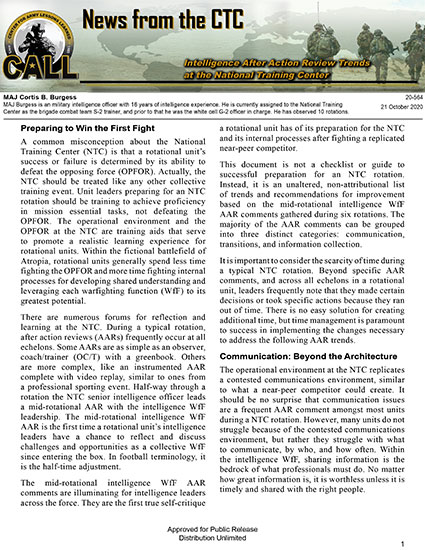 NFTCTC - Intelligence After Action Review Trends at the National Training Center
NFTCTC - Intelligence After Action Review Trends at the National Training Center
This article delivers an unaltered, non-attributional list of trends and recommendations for improvement based on the mid-rotational intelligence warfighting function after action review (AAR) comments gathered during six rotations. The majority of the AAR comments can be grouped into three distinct categories: communication, transitions, and information collection.
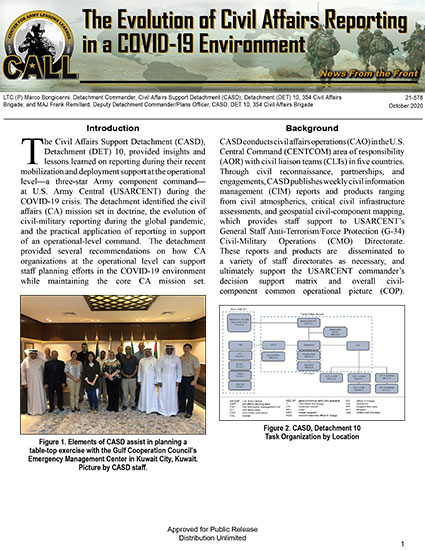 21-578 - News From the Front: The Evolution of Civil Affairs Reporting in a COVID-19 Environment
21-578 - News From the Front: The Evolution of Civil Affairs Reporting in a COVID-19 Environment
Members of Civil Affairs Support Detachment 10 provided insights and lessons learned on reporting during their recent mobilization and deployment support as part of U.S. Army Central during the COVID-19 crisis. The detachment identified the civil affairs mission set in doctrine, the evolution of civil-military reporting during the global pandemic, and the practical application of reporting in support of an operational-level command. The detachment provided several recommendations on how organizations at the operational level can support staff planning efforts in the COVID-19 environment while maintaining core mission set.
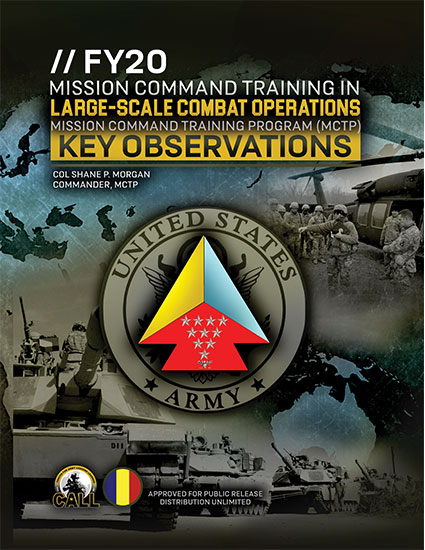 20-568 - FY20 Mission Command Training in Large-Scale Combat Operations - Mission Command Training Program (MCTP) Key Observations
20-568 - FY20 Mission Command Training in Large-Scale Combat Operations - Mission Command Training Program (MCTP) Key Observations
The information in this bulletin is a snapshot of the Army conducting large-scale combat operations. MCTP’s observations are primarily written by a collaborative group of experienced officers, noncommissioned officers, and chief warrant officers working in conjunction with highly qualified expert-senior mentors. MCTP uses several avenues to facilitate shared understanding of Warfighter Exercise (WFX) experiences to educate not just those units preparing for WFXs, but the total Army. Beginning in FY21, the MCTP WFX key observations will be published semiannually by CALL. The new publications will be more portable, pocket-sized books and will remain packed with current and relevant observations.
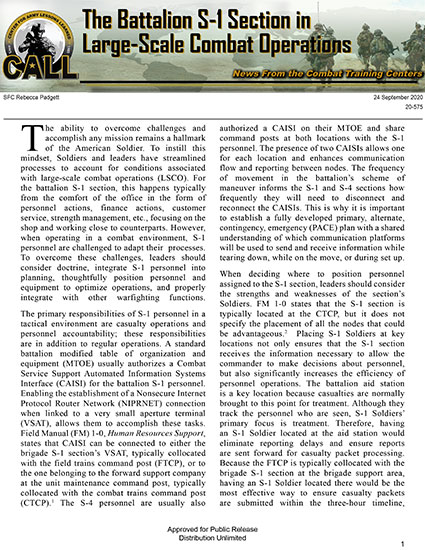 20-575 - The Battalion S-1 Section in Large-Scale Combat Operations
20-575 - The Battalion S-1 Section in Large-Scale Combat Operations
The ability to overcome challenges and accomplish any mission remains a hallmark of the American Soldier. To instill this mindset, Soldiers and leaders have streamlined processes to account for conditions associated with large-scale combat operations. For the battalion S-1 section, this happens typically from the comfort of the office in the form of personnel actions, finance actions, customer service, strength management, etc., focusing on the shop and working close to counterparts. However, when operating in a combat environment, S-1 personnel are challenged to adapt their processes. To overcome these challenges, leaders should consider doctrine, integrate S-1 personnel into planning, thoughtfully position personnel and equipment to optimize operations, and properly integrate with other warfighting functions.
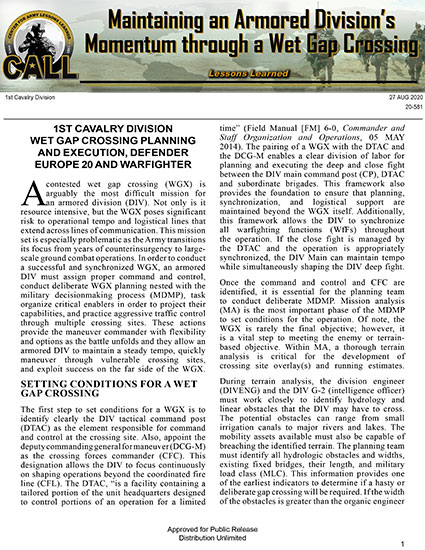 Maintaining an Armored Division’s Momentum through a Wet Gap Crossing
Maintaining an Armored Division’s Momentum through a Wet Gap Crossing
A contested wet gap crossing (WGX) is arguably the most difficult mission for an armored division. Not only is it resource intensive, but the WGX poses significant risk to operational tempo and logistical lines that extend across lines of communication. In order to conduct a successful and synchronized WGX, an armored division must assign proper command and control, conduct deliberate WGX planning nested with the military decision-making process (MDMP), task
organize critical enablers in order to project their capabilities, and practice aggressive traffic control through multiple crossing sites. These actions provide the maneuver commander with flexibility and options as the battle unfolds and they allow an
armored division to maintain a steady tempo, quickly maneuver through vulnerable crossing sites, and exploit success on the far side of the WGX. This article outlines some of the 1st Cavalry Division's lessons from planning and execution during Defender Europe 20 and a Warfighter exercise.
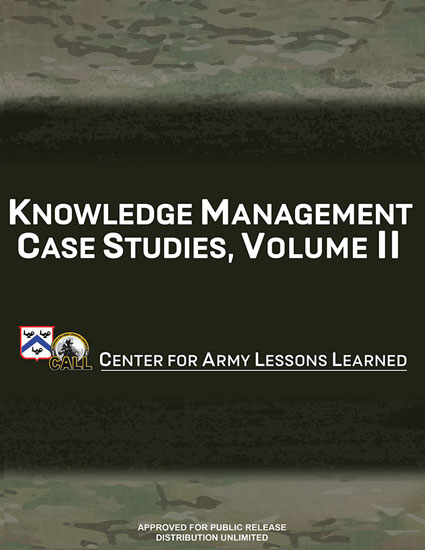 Knowledge Management Case Studies, Volume II
Knowledge Management Case Studies, Volume II
These Knowledge Management (KM) case studies highlight where an empowered KM officer applied KM principles to solve a problem. The KM officers in each case study achieved success by exercising initiative, applying critical and creative thinking, and ultimately delivering a capability or process that made their teams more effective and efficient. The Army’s data, information, and knowledge environment will continue to become more complex. These case studies provide illustrative examples of KM practices in action, and stimulate thinking among leaders and staffs looking to harness the power of KM in their headquarters.
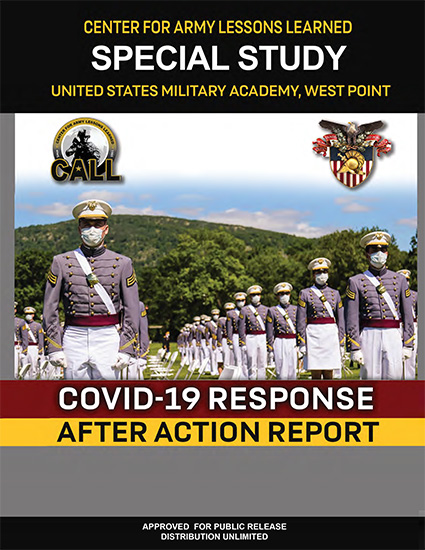 USMA COVID-19 Response AAR
USMA COVID-19 Response AAR
Like many other civilian academic institutions and military training
centers, the U.S. Military Academy (USMA), located in West Point, New York,
was impacted by the coronavirus pandemic which also affected the entire
world in the spring of 2020. The USMA staff quickly initiated planning to
develop a response to COVID-19. Planning resulted in a campaign plan that
focused on four major key tasks: return and reception of the graduating
class of 2020, the graduation of the class of 2020, subsequent cadet summer
training, and activities surrounding the reception of the new Plebe class in
late summer. All planning needed to balance the immediate impact of health
as a risk to force against the risk to mission of developing leaders of
character. There were many lessons learned and best practices identified throughout the
three months in which "Operation Resilient Knight" was developed and then
transitioned into execution. Contained within this report are the key points
identified during the Center for Army Lessons Learned collection, which was
conducted on the Academy grounds. There are many points upon which to grow
and improve. Additionally, many of these points may serve as waypoints for
other educational institutions and training commands to imitate as they
also chart a path to return to training amid the coronavirus threat.
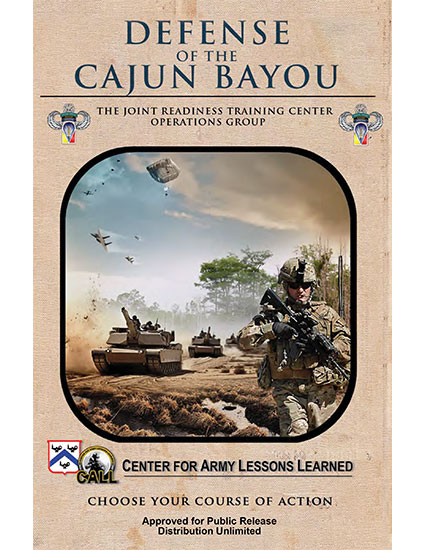 20-16: Defense of the Cajun Bayou
20-16: Defense of the Cajun Bayou
This book is an effort to reach units prior to their arrival in Louisiana by giving them realistic scenarios to think about while following the Cajun Brigade through the planning and execution of a defense. While reading, take note of the guidance the brigade commander provides his staff. Watch the staff focus on achieving the commander’s guidance through its planning sessions. Study how the staff primaries take an active role in their struggle to understand and apply that guidance. Empathize with them as they do it all under the duress and tyranny of time. Throughout, the authors have provided an opportunity for the reader to take an active role.
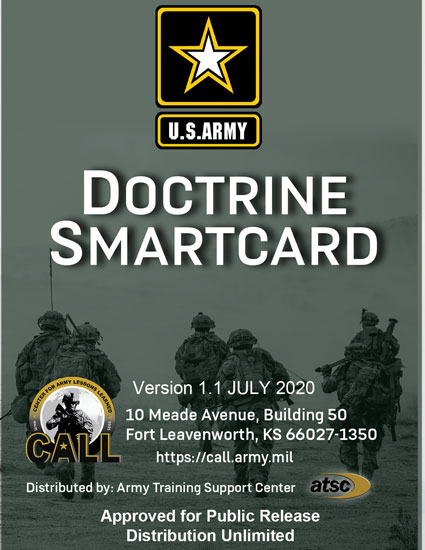 GTA 19-10-007: Doctrine SmartCard
GTA 19-10-007: Doctrine SmartCard
Analysts from the Center for Army Lessons Learned, having observed numerous iterations of the Mission Command Training Program’s Warfighter Exercises and Combat Training Center rotations, have identified key doctrinal areas that most junior Soldiers and leaders routinely reference. These include areas relevant to Army planning and Army offensive and defensive operations. This quick reference aid aims to help Soldiers quickly identify and reference key doctrinal terms and steps in high operational tempo training environments.
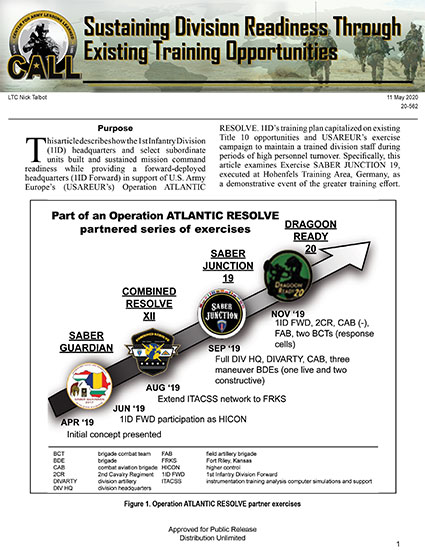 News From the Front: Sustaining Division Readiness Through Existing Training Opportunities
News From the Front: Sustaining Division Readiness Through Existing Training Opportunities
This article describes how the 1st Infantry Division and select subordinate units built and sustained mission command readiness while providing a forward-deployed headquarters in support of USAREUR’s Operation ATLANTIC RESOLVE.
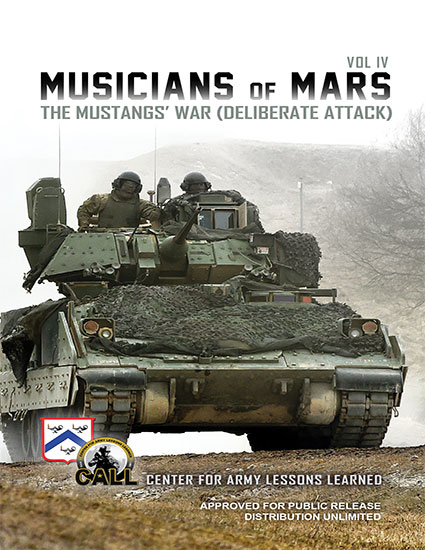 Musicians of Mars IV: The Mustangs’ War (Deliberate Attack)
Musicians of Mars IV: The Mustangs’ War (Deliberate Attack)
LTC Milner and the Soldiers of Task Force (TF) Mustang are back in this final installment of the series. Its focus is on tactical leaders’ decisions as TF Mustang transitions from a hasty pursuit to a more deliberate offensive operation. As with previous volumes, tactical leaders’ decisions, both good and poor, are designed to stimulate discussion of small-unit training, leadership, professionalism, and planning in a large-scale combat operation. Characters in the work, as well as their subordinates, are human and will make mistakes. They will also use realistic language, talk about their interests, and display prejudices or anger toward enemy forces that may alarm some readers. Musicians of Mars IV displays leader progression as its protagonists advance through combat operations. CALL anticipates that this volume will facilitate unit-level professional development in the same manner its three predecessors did. Whether discussing combined arms breaches or reconnaissance and security operations, LTC Milner and his subordinates are intended to be an avenue through which battalion and field grade officers can initiate a professional discussion with their subordinates.
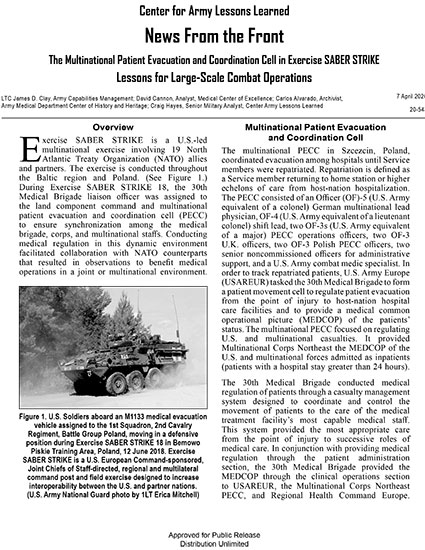 NFTF - Multinational Patient Evacuation and Coordination Cell 20-543
NFTF - Multinational Patient Evacuation and Coordination Cell 20-543
Exercise SABER STRIKE is a U.S.-led multinational exercise involving 19 North Atlantic Treaty Organization (NATO) allies and partners. The exercise is conducted throughout the Baltic region and Poland. During Exercise SABER STRIKE 18, the 30th Medical Brigade liaison officer was assigned to the land component command and multinational patient evacuation and coordination cell to ensure synchronization among the medical brigade, corps, and multinational staffs. Conducting medical regulation in this dynamic environment facilitated collaboration with NATO counterparts that resulted in observations to benefit medical operations in a joint or multinational environment.
Pages
Handbooks
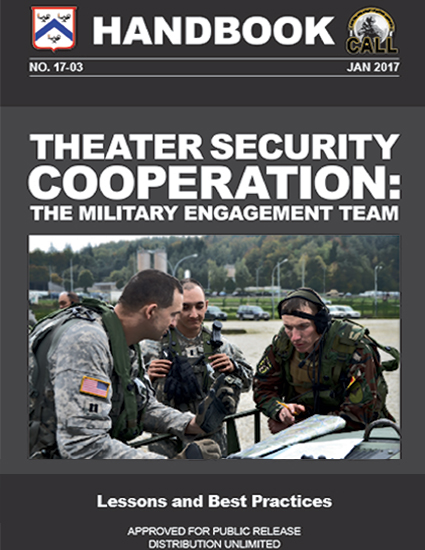 17-03 Theater Security Cooperation: The Military Engagement Team Handbook
17-03 Theater Security Cooperation: The Military Engagement Team Handbook
This handbook describes the Military Engagement Team (MET) and its use in strengthening and building partnerships. Additionally it describes MET structure, training and operational employment as well as its training and structure. This handbook will provide value for future MET members in order to better understand the MET. It is also useful for MET and non MET members alike who will be conducting engagements with partner nations.
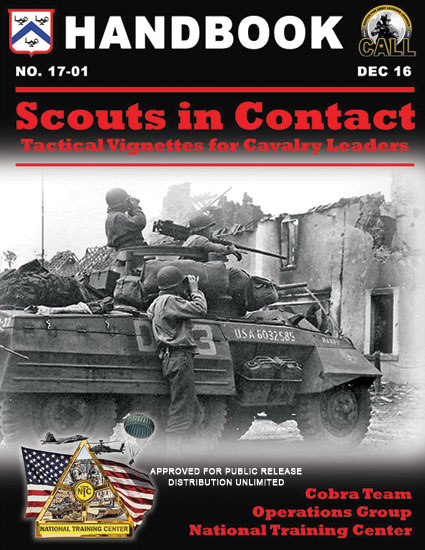 17-01: Scouts in Contact; Tactical Vignettes for Cavalry Leaders Handbook
17-01: Scouts in Contact; Tactical Vignettes for Cavalry Leaders Handbook
Looking for innovative ways to train junior leaders in reconnaissance? Look no further. Vignettes, developed by the subject matter experts at NTC, lead teams through a variety of scenarios that will challenge and mature your young reconnaissance leaders’ decision-making skills. Facilitator instructions guarantee you have the information needed to make you and your reconnaissance teams successful!
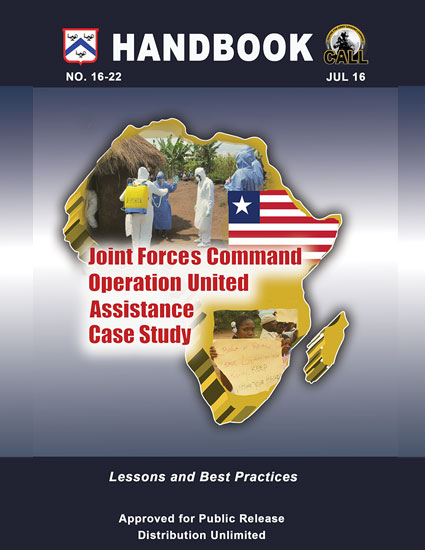 16-22 Joint Forces Command Operation United Assistance Case Study Handbook
16-22 Joint Forces Command Operation United Assistance Case Study Handbook
The Department of the Army chose the Southern European Task Force to become the Army component headquarters for U.S. Africa Command (USAFRICOM) in December 2008. Subsequently, U.S. Army Africa (USARAF) was designated as the Army Service component command (ASCC) for USAFRICOM in January 2012. The USAFRICOM commander directed USARAF to focus on four major tasks:
- Supporting ongoing operations
- Fulfilling Title 10, U.S. Code, responsibilities
- Executing theater security cooperation missions
- Deploying joint task force-capable headquarters
USARAF, without assigned forces and the typical theater enablers, was presented a challenge in accomplishing its diverse missions. From its inception, USARAF has been dependent on other organizations, regionally aligned forces (RAF), and the global force management process to accomplish its mission. Operation United Assistance (OUA) provided a good laboratory in which to study the present theater army concept and to consider where it needs adjusting or modification in the future.
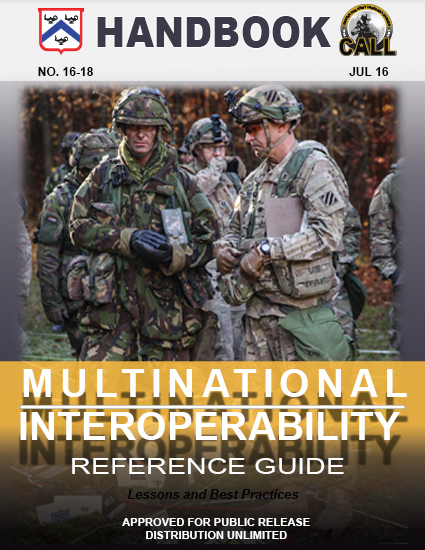 16-18 Multinational interoperability Reference Guide Handbook
16-18 Multinational interoperability Reference Guide Handbook
The challenges and complexity of the future will require the Army to provide a broader range of capabilities to achieve strategic outcomes across a complex and diverse range of global missions. The Army Vision cites "integrate operations" as one of the unique roles performed by the Army, providing combatant commanders with foundational capabilities, to include headquarters capable of integrating joint, interagency, and multinational operations. In the future, the need for interoperability will extend to lower echelons of Army forces in order to effectively integrate smaller national contributions into multinational operations.
 Musicians of Mars II
Musicians of Mars II
This handbook is a sequel to CALL Publication 90-06, The Musicians of Mars: A Story of Synchronization for the Company/Team Commander, June 1990.
This short story was written to emphasize critical synchronization tasks, combat leadership principles, and factors for consideration, primarily for company/team commanders but also for leaders throughout tactical-level units. The importance of integrating and synchronizing available combat power, both lethal and nonlethal, in the decisive action environment against potential hybrid threats is critical to unit success on the battlefield.
Musicians of Mars II is written from the perspectives of two company/team commanders and the task force commander in a deliberate defense scenario against a fictional hybrid threat, based on current worldwide potential threats. It explores successes and shortcomings in the planning, preparation and execution of the defense, providing considerations and points of emphasis for tactical leaders.
This quick reference guide describes U.S. Army organizations, planning, and operations. Unified action partners (UAPs) are those military forces, of the private sector with whom U.S. Army forces plan, coordinate, synchronize, and integrate during the conduct of operations (Army Doctrine Reference Publication 3-0, Unified Land Operations).
UAPs include joint forces (activities in which elements of two or more U.S. military departments participate), multinational forces, and U.S Government (USG) agencies and departments. The Iraq and Afghanistan wars highlight the necessity for collaboration,
cooperation, and synchronization among USG, NGOs, and private sector agencies to focus the elements of national power in achieving national strategic objectives. Our experience in these conflicts accentuates the importance of foreign governments, agencies, and militaries participating, in concert with the United States, to achieve common objectives. Meeting the challenges of complex environments, infused with fragile or failing nation states, non-state actors, pandemics, natural disasters, and limited resources, requires the concerted effort of all instruments of U.S. national power plus foreign governmental agencies, military forces, and civilian organizations.
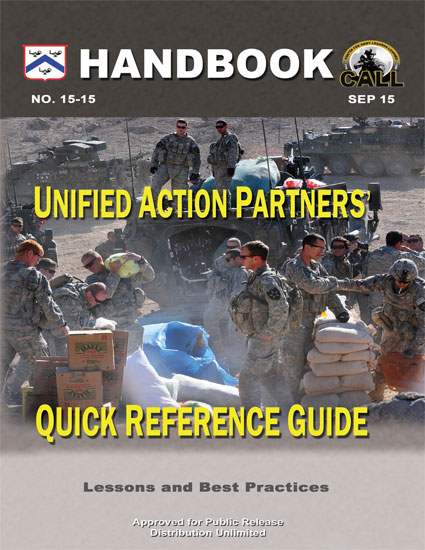 15-15 Unified Action Partners' Quick Reference Guide
15-15 Unified Action Partners' Quick Reference Guide
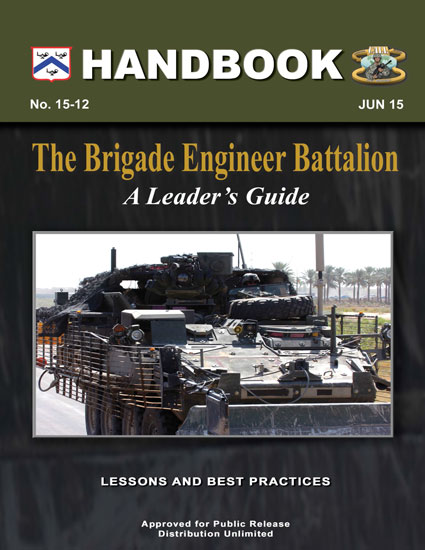 15-12 The Brigade Engineer Battalion - A Leader’s Guide
15-12 The Brigade Engineer Battalion - A Leader’s Guide
Maneuver commanders rely on engineers to add breadth and depth to the overall understanding of the operational environment. The engineer perspective shares a common understanding of the operational environment, while adding a degree of focus on those aspects within an engineering background. The engineer, employing the common analytical framework and a unique technical background, identifies significant and relevant challenges and opportunities of potential impact to the combined arms operation.
 15-11 Center for Army Lessons Learned Services Handbook
15-11 Center for Army Lessons Learned Services Handbook
The Center for Army Lessons Learned (CALL) is an agent for change focused on the collection, analysis, dissemination, integration, and archiving of new concepts, best practices, and doctrine, organization, training, materiel, leadership and education, personnel, and facilities (DOTMLPF) solutions throughout the Army from the tactical through theater/strategic levels of war. This handbook should assist you in understanding CALL and how you and your unit can participate in, and profit from, the lessons learned program.
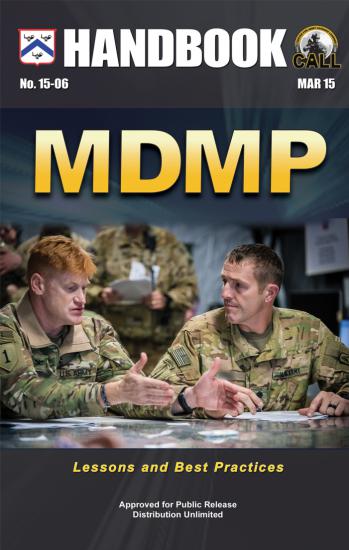 15-06 MDMP Lessons and Best Practices Handbook
15-06 MDMP Lessons and Best Practices Handbook
Historically, a unit's success is directly related to the ability of the staff to execute the military decisionmaking process (MDMP). Given the increased complexity of today's operational environment and the vast array of mission command systems and processes, integration and synchronization of all activities associated with operations are increasingly difficult. Observations derived from deployed units, as well as from trainers at Combat Training Centers (CTCs) over the past decade, indicate a significant loss of unit ability to conduct a detailed MDMP. This lack of planning expertise results in de-synchronized operations, and could ultimately cost the lives of Soldiers. There are numerous key doctrinal manuals that address MDMP. This handbook is designed to consolidate much of this doctrine, combined with analysis of observations from recent deployments and CTC rotations, into a single source that is useful to junior leaders as they conduct the MDMP. More detailed study of the MDMP can be accomplished by studying the key doctrinal manuals listed in Chapter 13 of this handbook.
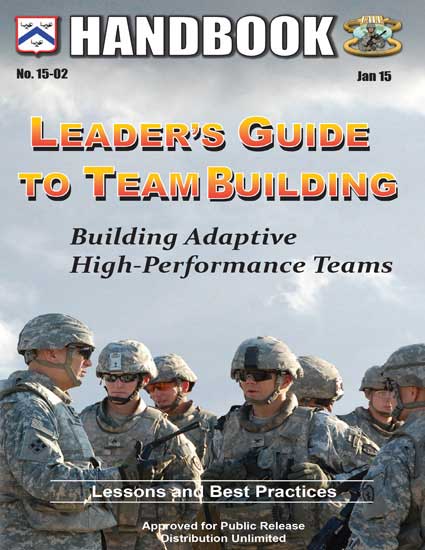 15-02 Leader's Guide to Team Building Handbook
15-02 Leader's Guide to Team Building Handbook
The Leader's Guide to Team Building handbook provides lessons and best practices ("a way") to rapidly build and effectively employ cross-boundary teams that are highly competent both in making and executing decisions and in learning and adapting together. It helps the team gain common understanding of the situation and requirements and quickly reach a higher level of performance.
 15-01 Command Deployment Discipline Handbook
15-01 Command Deployment Discipline Handbook
The Command Deployment Discipline Program (CDDP) is a commander’s tool designed to enhance unit deployment readiness. This handbook is a combination of doctrinal and regulatory tasks that address Army standards, fundamentally focused on equipment movement and associated tasks from division to company level, to include installation tasks.
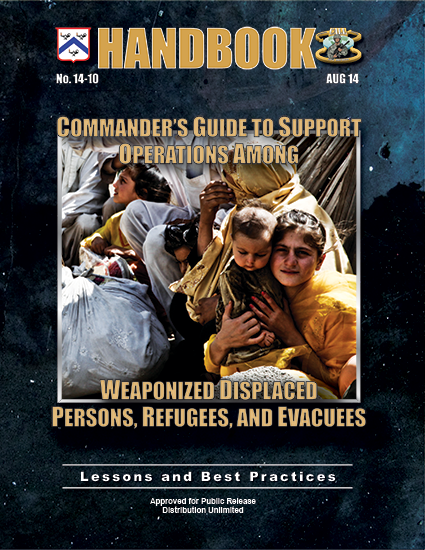 14-10 Commander's Guide to Support Operations Among Weaponized Displaced Persons, Refugees, and Evacuees
14-10 Commander's Guide to Support Operations Among Weaponized Displaced Persons, Refugees, and Evacuees
The use of chemical and biological weapons on the battlefields of history is not a new phenomenon. Although this practice is contrary to international treaties and customs, it has not precluded the use of these weapons by state and non-state actors against military, political, or civilian targets. Chemical and biological weapons use during the Iran–Iraq war in the 1980s and the use of chemical weapons in Syria in 2013 demonstrate that our collective security is threatened by actors willing to defy the international community. The threat of chemical and biological weapons use is increased as these are relatively inexpensive to produce and can be delivered by a variety of methods, making them an asymmetric threat of catastrophic potential. The psychological, health, and logistical implications of displaced persons fleeing a real or perceived chemical, biological, radiological, nuclear, and enhanced conventional weapons (CBRNE) environment will create complex mission command and support requirements requiring innovative and agile responses.
Pages
Newsletters
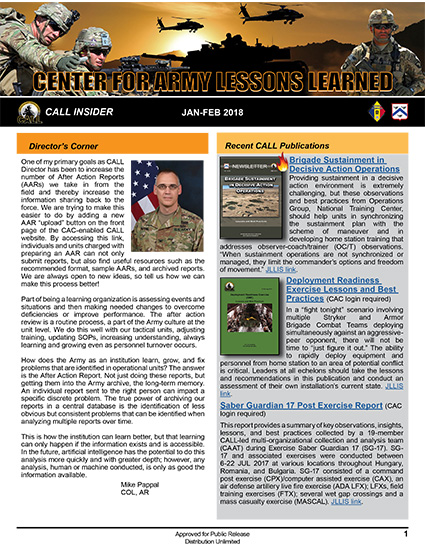 CALL Insider Newsletter Jan-Feb 2018
CALL Insider Newsletter Jan-Feb 2018
CALL Insider Newsletter Jan-Feb 2018
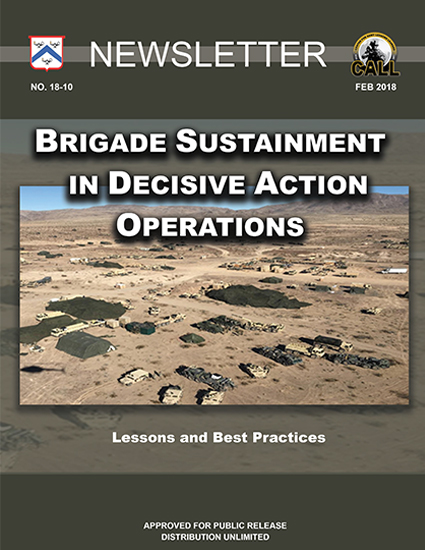 18-10 - Brigade Sustainment in Decisive Action Operations Newsletter
18-10 - Brigade Sustainment in Decisive Action Operations Newsletter
The following collection outlines observations and best practices from the National Training Center (NTC). It exposes the challenges of providing sustainment in a decisive action environment but should assist units to tie the sustainment plan with the scheme of maneuver. It should also help develop home station training to address current gaps and shortfalls observed at the NTC.
The topics examined in this newsletter include the following: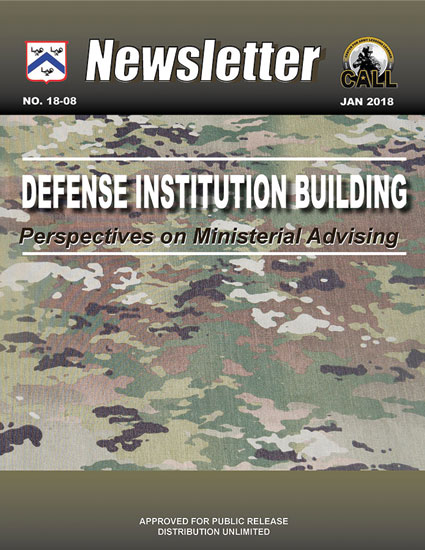 18-08 Defense Institution Building Perspectives on Ministerial Advising Newsletter
18-08 Defense Institution Building Perspectives on Ministerial Advising Newsletter
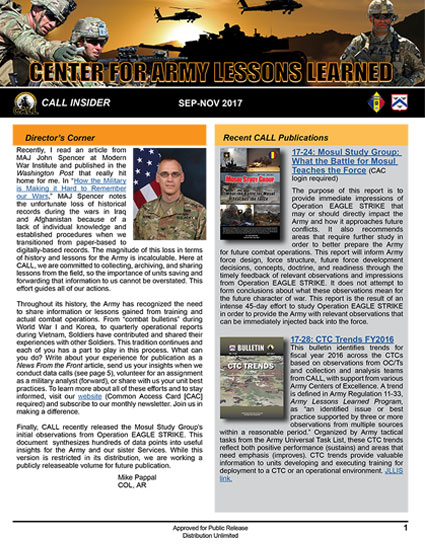 CALL Insider Newsletter SEP-NOV 2017
CALL Insider Newsletter SEP-NOV 2017
Recently, I read an article from
MAJ John Spencer at Modern
War Institute and published in the
Washington Post that really hit
home for me. In “How the Military
is Making it Hard to Remember
our Wars,” MAJ Spencer notes
the unfortunate loss of historical
records during the wars in Iraq
and Afghanistan because of a
lack of individual knowledge and
established procedures when we
transitioned from paper-based to
digitally-based records. The magnitude of this loss in terms
of history and lessons for the Army is incalculable. Here at
CALL, we are committed to collecting, archiving, and sharing
lessons from the field, so the importance of units saving and
forwarding that information to us cannot be overstated. This
effort guides all of our actions.
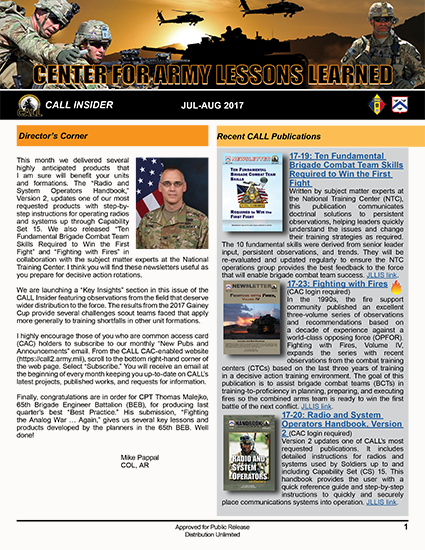 CALL Insider Newsletter Jul-Aug 2017
CALL Insider Newsletter Jul-Aug 2017
This month we delivered several highly anticipated products that I am sure will benefit your units and formations. The “Radio and System Operators Handbook,” Version 2, updates one of our most requested products with step-bystep instructions for operating radios and systems up through Capability Set 15. We also released “Ten Fundamental Brigade Combat Team Skills Required to Win the First Fight” and “Fighting with Fires” in collaboration with the subject matter experts at the National Training Center. I think you will find these Newsletters useful as you prepare for decisive action rotations.
Ten Fundamental Brigade Combat Team Skills Required to Win the First Fight
This newsletter consists of ten chapters focusing on ten fundamental skills designed to communicate doctrinal solutions to the persistent observations from the National Training Center. The goal is to better prepare brigade combat teams to decisively win the first fight of the next war. These fundamental skills will enable leaders at echelon to quickly understand issues and change their training strategies, as required.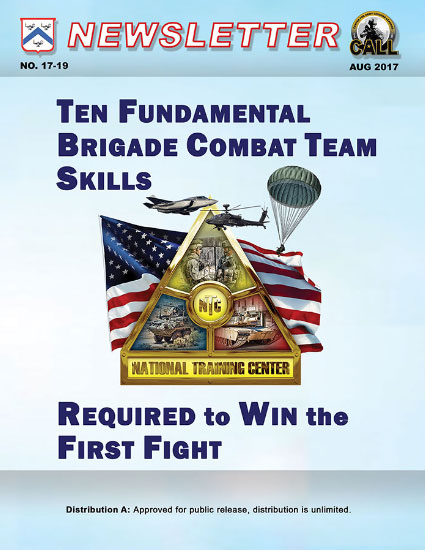 17-19: Ten Fundamental Brigade Combat Team Skills Newsletter
17-19: Ten Fundamental Brigade Combat Team Skills Newsletter
1. Commander-driven operations process
2. Combined arms breaching
3. Decisive action in an urban environment
4. Operations in a cyber electromagnetic activities (CEMA)-denied environment
5. Reconnaissance and security
6. Digital fires capability (sensor to shooter)
7. Counterfire
8. Chemical, biological, radiological, nuclear, and high-yield explosives (CBRNE) in decisive action
9. Joint force integration and interoperability
10. Sustainment in decisive action These ten fundamental skills were derived from senior leader input, persistent observations, and trends. They will be re-evaluated and updated regularly to ensure the National Training Center operations group provides the best feedback to the force that will enable brigade combat teams’ success.
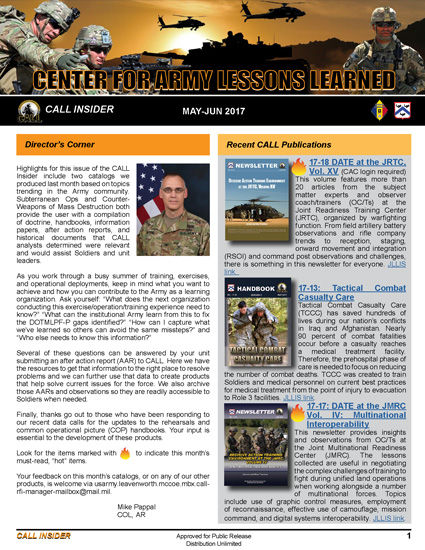 CALL Insider Newsletter May-Jun 2017
CALL Insider Newsletter May-Jun 2017
CALL Insider include two catalogs we produced last month based on topics trending in the Army community. Subterranean Ops and Counter-Weapons of Mass Destruction both provide the user with a compilation of doctrine, handbooks, information papers, after action reports, and historical documents that CALL analysts determined were relevant and would assist Soldiers and unit leaders.
This newsletter is a must read for any organization attending any CTC or any event partnering with multinational forces.
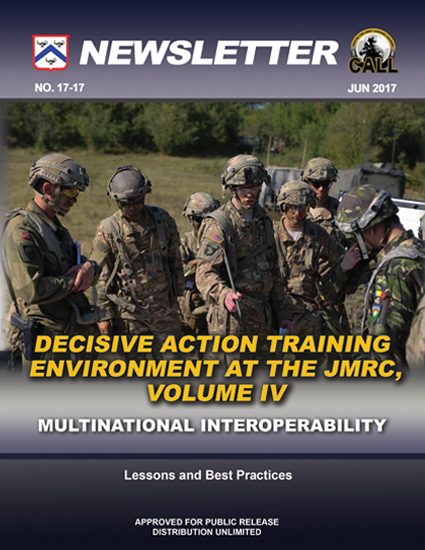 17-17: DATE at the JMRC, Volume IV Newsletter
17-17: DATE at the JMRC, Volume IV Newsletter
The DATE at the JMRC Newsletter Vol IV contains articles written by Observer/Controller Trainers from the Joint Multinational Readiness Center. This newsletter covers topics such as:
- Multinational Interoperability
- Joint and multinational Fires
- Fratricide Avoidance
- Mission Command
- Camouflage
- Reconnaissance using multinational Task Force
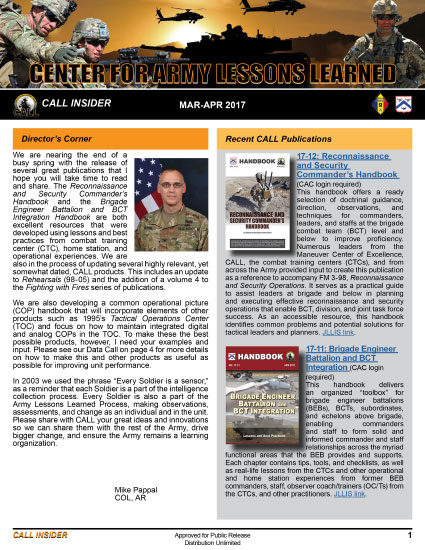 CALL Insider Newsletter Mar-Apr 2017
CALL Insider Newsletter Mar-Apr 2017
We are nearing the end of a
busy spring with the release of
several great publications that I
hope you will take time to read
and share.
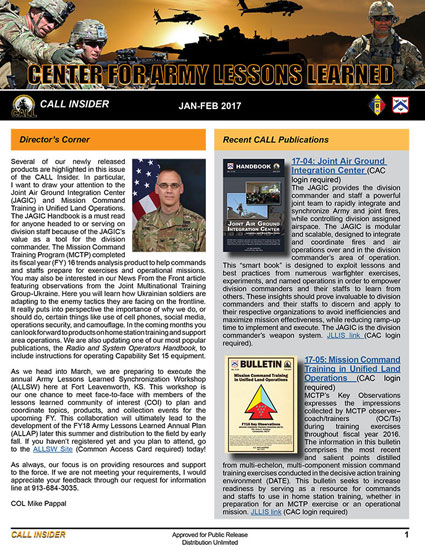 CALL Insider Newsletter Jan-Feb 2017
CALL Insider Newsletter Jan-Feb 2017
Several of our newly released products are highlighted in this Jan-Feb 2017 issue of the CALL Insider Newsletter.
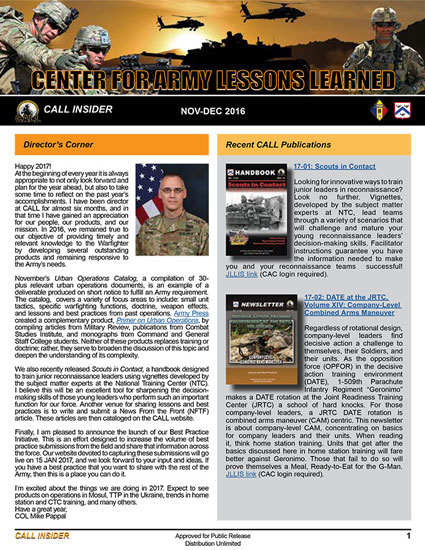 CALL Insider Newsletter Nov-Dec 2016
CALL Insider Newsletter Nov-Dec 2016
Happy 2017!
At the beginning of every year it is always
appropriate to not only look forward and
plan for the year ahead, but also to take
some time to reflect on the past year’s
accomplishments. I have been director
at CALL for almost six months, and in
that time I have gained an appreciation
for our people, our products, and our
mission. In 2016, we remained true to
our objective of providing timely and
relevant knowledge to the Warfighter
by developing several outstanding
products and remaining responsive to
the Army’s needs.
The Joint Readiness Training Center (JRTC) turned to decisive action training with what was called, at the time, a full spectrum operations (FSO) rotation in October 2010. The shift to a decisive action training environment (DATE) did not lessen the challenges of FSO; it merely placed them inside DATE as a more accurate depiction of unified land operations.
Regardless of rotational design (FSO versus DATE), company-level leaders find decisive action a challenge for themselves, their Soldiers, and their units. As the opposition force (OPFOR) in the DATE, 1st Battalion, 509th Parachute Infantry Regiment (Geronimo) made the DATE rotation at the JRTC a “school of hard knocks.” For those company-level leaders, a JRTC DATE rotation was combined arms maneuver (CAM) centric.
This newsletter is about company-level CAM, concentrating on basics for company leaders and their units. When reading it, think home-station training. Units that get after the basics discussed here during home-station training fare better against Geronimo. Those that do not will prove themselves a meal ready-to-eat for the Geronimo personnel.
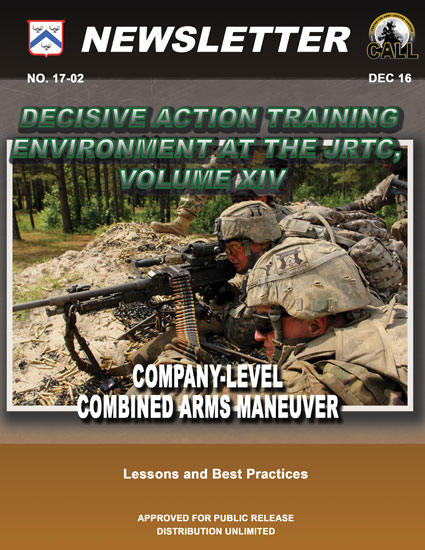 17-02: DATE at the JRTC, Volume XIV
17-02: DATE at the JRTC, Volume XIV
Pages
News from the Front
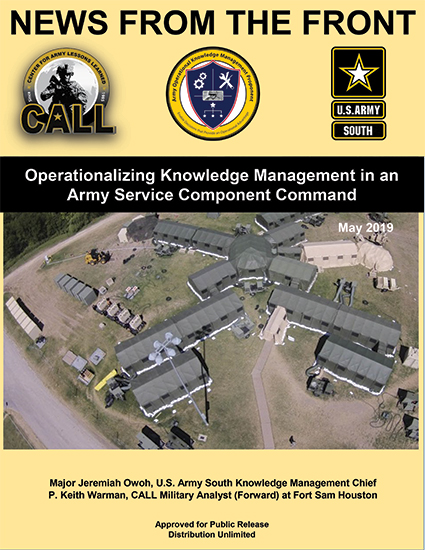 NFTF - Operationalizing Knowledge Management in an Army Service Component Command
NFTF - Operationalizing Knowledge Management in an Army Service Component Command
This article is an account of the experience and initiative that drove major change in the U.S. Army South Knowledge Management (KM) program from 2017-19. This record of enhanced practices and procedures is based on both doctrine and best practices. Although compiled from the capabilities and requirements of a single unit, the insights and lessons have applicability across the force, certainly with other Army Service component commands.
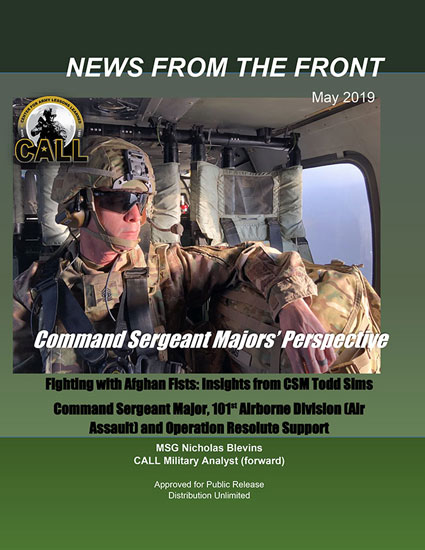 NFTF - Fighting with Afghan Fists: Insights from CSM Todd Sims
NFTF - Fighting with Afghan Fists: Insights from CSM Todd Sims
This News from the Front, a Center for Army Lessons Learned (CALL) publication, highlights Command Sergeant Major (CSM) Todd Sims’ insights and observations during his deployment in support of Operation FREEDOM’S SENTINEL and the North Atlantic Treaty Organization (NATO)-led RESOLUTE SUPPORT mission. The interview and unit information is provided solely by the CSM of the 101st Airborne Division (Air Assault) at Bagram Airfield, Afghanistan on 2 December 2018.
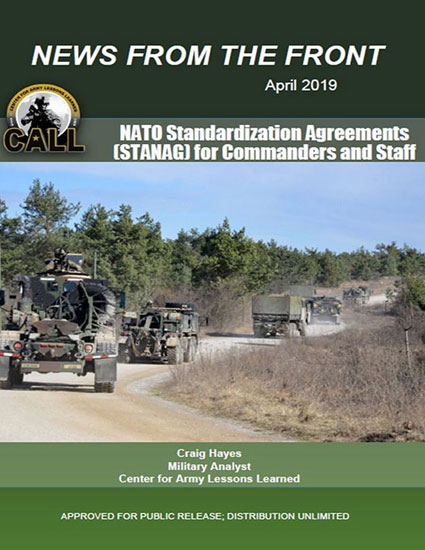 News From The Front: NATO Standardization Agreements (STANAG) for Commanders and Staff
News From The Front: NATO Standardization Agreements (STANAG) for Commanders and Staff
This news from the front is the result of a CALL study analyzing recent exercises in Europe that determined common interoperability areas for improvement. When operating with a European based multinational force, what are the NATO Standardization Agreements (STANAG) for interoperability? After identifying areas for improvement, CALL conducted a review of NATO STANAGs and publications to address those issues. This publication informs the force of NATO STANAGs to consider enabling success in the next multinational exercise.
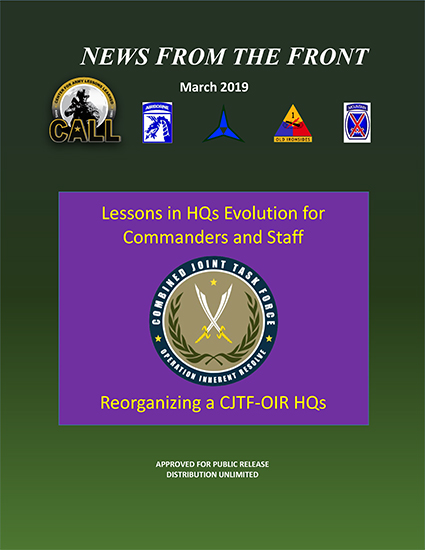 NFTF - Lessons in HQs Evolution for Commanders and Staff, Reorganizing a CJTF-OIR HQs
NFTF - Lessons in HQs Evolution for Commanders and Staff, Reorganizing a CJTF-OIR HQs
This News From the Front article provides a history of CJTF-OIR headquarters evolution and actions taken by the staff to plan, prepare, and execute organizational change from 1 December 2017 to 28 February 2018.
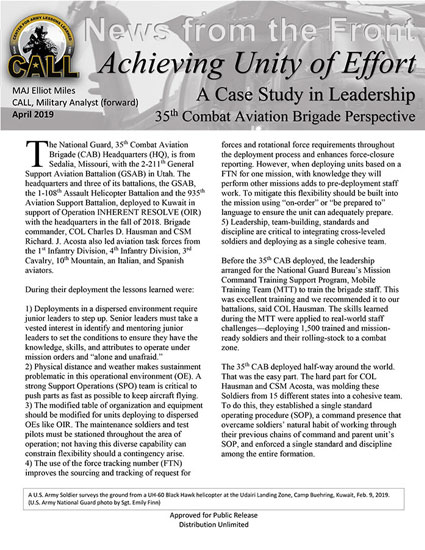 News From The Front: Achieving Unity of Effort - A Case Study in Leadership
News From The Front: Achieving Unity of Effort - A Case Study in Leadership
Military operations are fundamentally joint, interagency, and multinational (JIM) in character (multi-state in the case of National Guard units) requiring contributions from multiple JIM partners (or states). Achieving unity of effort in the execution of the mission will be critical to reducing both the risks of failure and the costs of success. This News From the Front examines the 35th Combat Aviation Brigade’s mission in support of Operation INHERENT RESOLVE and their trials and tribulations to achieve unity of effort.
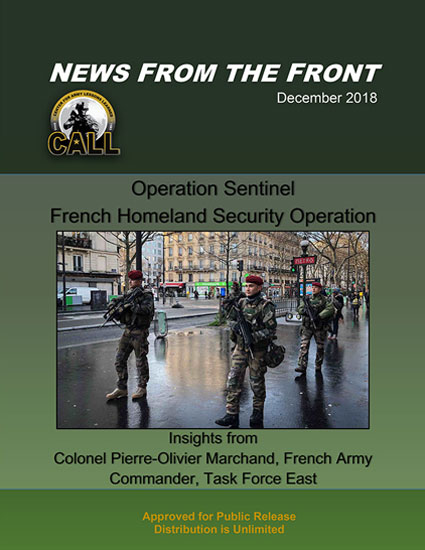 News From the Front - Operation Sentinel French Homeland Security Operation
News From the Front - Operation Sentinel French Homeland Security Operation
This interview, conducted by the Center for Army Lessons Learned, captures the insights from Colonel Pierre-Olivier Marchand, French Army, who was commander of an artillery regiment in the 11th Airborne Brigade when tasked with leading one of the task forces responsible for conducting Operation Sentinel in Paris.
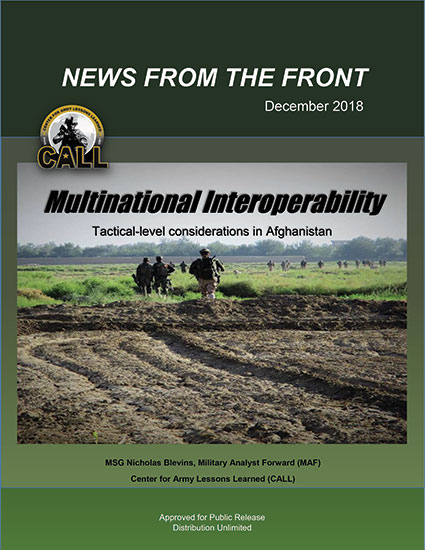 NFTF - Multinational Interoperability: Tactical-level considerations in Afghanistan
NFTF - Multinational Interoperability: Tactical-level considerations in Afghanistan
This article highlights Task Force (TF) Manchu operations, activities, and actions focusing on deployment train-up, mission planning, and mission execution. The TF executed three lines of effort (LOEs) in support of Operation Freedom Sentinel: 1. Protecting the largest base in Afghanistan (Bagram Airfield), 2. Disrupting the enemy, and 3. Enabling Afghan partners. The seamless execution of these LOEs helped TF Manchu excel at multinational interoperability.
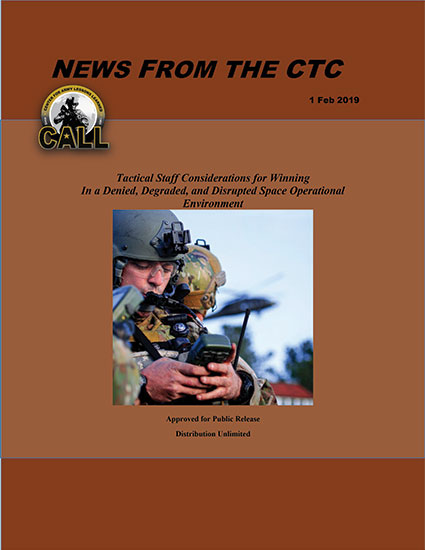 NFTF - Tactical Staff Considerations for Winning In a Denied, Degraded, and Disrupted Space Operational Environment
NFTF - Tactical Staff Considerations for Winning In a Denied, Degraded, and Disrupted Space Operational Environment
This paper discusses the space equities within the electromagnetic spectrum, specifically the military's reliance on Global Positioning System (GPS); satellite communications (SATCOM); and space-based intelligence, surveillance, and reconnaissance platforms, as well as the corresponding mitigating tasks necessary to retain the Unites States' advantage in space. The ability of the U.S. Army to operate in a D3SOE ensures increased levels of force protection for its Soldiers while preserving its means to deliver devastating effects upon enemy forces.
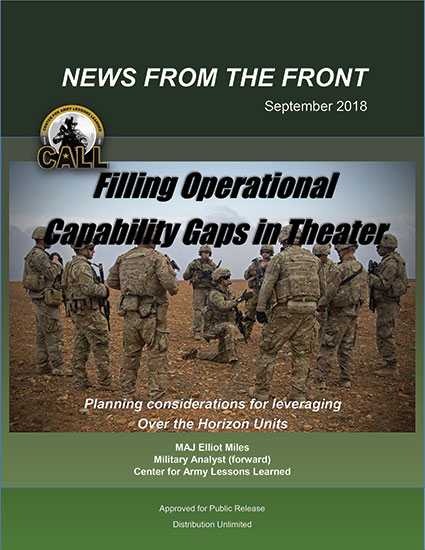 NFTF -- Filling Operational Capability Gaps in Theater
NFTF -- Filling Operational Capability Gaps in Theater
This article describes how Combined Joint Task Force-Operation Inherent Resolve (CJTF-OIR) worked toward implementing the Over the Horizon (OtH) concept. In a changing operational environment (OE) with limited resources and the need to seize opportunities, CJTF-OIR utilized available theater forces as an expeditious means to surge capacity where and when needed.
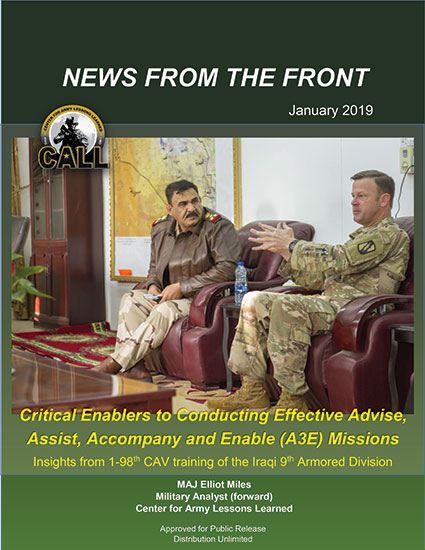 Critical Enablers to Conducting Effective Advise, Assist, Accompany and Enable (A3E) Missions
Critical Enablers to Conducting Effective Advise, Assist, Accompany and Enable (A3E) Missions
This article examines 1st Squadron, 98th Cavalry Regiment, 155th Armored Brigade Combat Team (Mississippi National Guard) in its advise, assist, accompany and enable (A3E) mission with the Iraqi 9th Armored Division. It covers a variety of observations, lessons, and insights from training to cultural awareness. It also addresses the inevitable challenges associated with an A3E mission and the reconciliation to reinforce the trust and relationship building with a partner nation.
 NFTF - Commanders Guide for Driving Change: The Learning Organization Framework
NFTF - Commanders Guide for Driving Change: The Learning Organization Framework
Is your unit consistently focused one or two echelons below, with fast approaching training events, missions, and 50 meter targets, without much consideration for sharing observations and lessons upon completion of events? If so, you are not alone -- this is a common pitfall of our busy profession; however, it is a resolvable issue given a relevant Learning Organization Framework. Highly developed learning organizations place emphasis on long-term problem solving, consistently modifying behavior, and sharing observations and lessons across the Army enterprise. To address the challenges of becoming a learning organization, leaders apply foresight, insight, and the education and training space required to create the conditions for learning. To effectively learn and ultimately solve problems, a process for developing, observing, capturing, sharing, and modifying lessons can be integrated into training and mission plans.
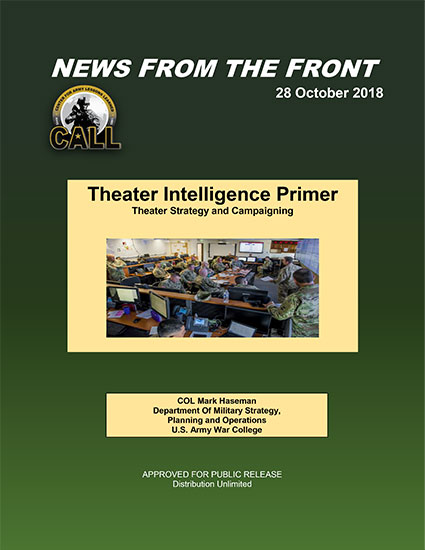 NFTF - Theater Intelligence Primer
NFTF - Theater Intelligence Primer
The intent of this primer is to educate commanders and senior staff to be involved, supportive consumers of intelligence. The goal is not to repeat doctrine—although doctrine references are noted. It provides the means by which the Combatant Command Commander (CCDR) can develop relationships with the defense intelligence enterprise and drive the intelligence effort. It places emphasis on how intelligence professionals should work to understand what the J5/J3/CCDR needs, and share the tools they have available.
Pages
Other Products
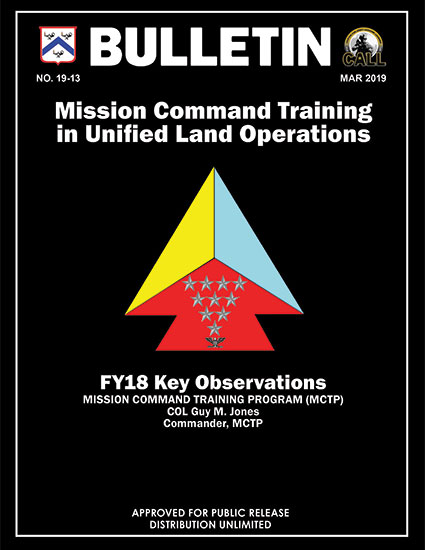 19-13 - Mission Command Training in Unified Land Operations FY18 Key Observations Bulletin
19-13 - Mission Command Training in Unified Land Operations FY18 Key Observations Bulletin
Mission Command Training Program (MCTP) trains Army functional/multi-functional/maneuver brigades, divisions, expeditionary sustainment commands (ESCs), corps, special operations units, and U.S. Air Force personnel in mission command and unified land operations. In accordance with the U.S. Army’s combat training center programs and the Chief of Staff of the Army’s training guidance, MCTP conducted five multi-echelon warfighter exercises (WFXs) and six brigade-level WFXs during fiscal year 2018 (FY18). Together, these exercises met the training objectives of more than 60 units. Additionally, MCTP worked closely with the Joint Staff J-7 and other training partners to infuse joint context within a WFX to properly stimulate a corps training audience in preparation for its future role as a joint task force (JTF).
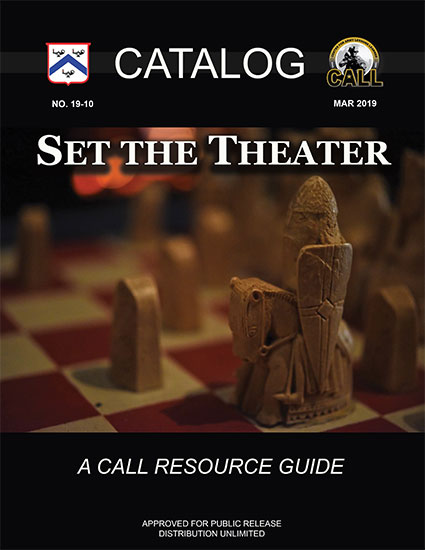 19-10 - Set The Theater Catalog
19-10 - Set The Theater Catalog
This catalog provides references for commanders and staff to enhance their understanding of the concept and details of setting a theater. The resources listed include current doctrine, handbooks, articles and other publications focused on setting the theater.
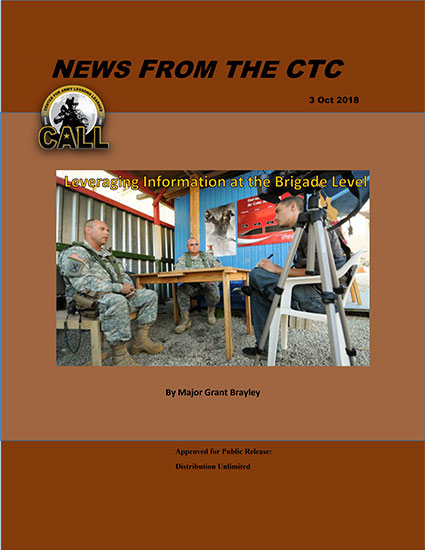 News From the CTC: Leveraging Information at the BDE level
News From the CTC: Leveraging Information at the BDE level
Information related capabilities (IRCs) such as military deception, civil affairs, electronic warfare, or cyber operations can be effectively exercised during phase III operations at the brigade (BDE) level. Successfully integrating IRCs improves BDE operations during all phases. Units have varying degrees of success in leveraging information for phase III. Here are trends Observer, Coach, Trainers (OC/Ts) at the Joint Multinational Readiness Center (JMRC) observed from U.S. and NATO Allies and partners as they executed decisive action (DATE) rotations.
 News From the CTC: Leveraging Information at the Brigade Level
News From the CTC: Leveraging Information at the Brigade Level
Information related capabilities (IRCs) can be effectively exercised during Phase III operations at the brigade (BDE) level. Successfully integrating IRCs improves BDE operations during all phases. Units have varying degrees of success in leveraging information for Phase III. This article outlines some observations Observer, Coach, Trainers at the Joint Multinational Readiness Center made regarding U.S. and NATO Allies and partners as they executed decisive action rotations.
 19-01: Security Cooperation and the State Partnership Program Bulletin
19-01: Security Cooperation and the State Partnership Program Bulletin
The State Partnership Program (SPP) is a Department of Defense (DOD) security cooperation program, managed and administered by the National Guard Bureau (NGB), executed and coordinated by the geographic combatant commands (GCCs), with personnel sourced by the National Guard. It is an innovative, small-footprint tool supporting the security cooperation goals of the GCCs and the U.S. Chief of Mission (CoM) for the partner nation (PN). This publication provides an overview of program highlights and activities.
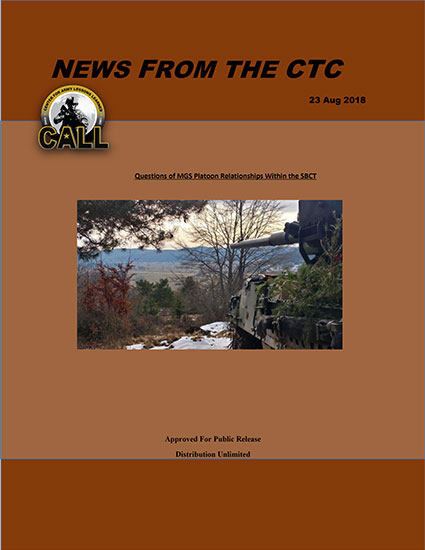 News From the CTC: Questions of MGS PLT Relationships Within the SBCT
News From the CTC: Questions of MGS PLT Relationships Within the SBCT
The purpose of this article is to discuss the command and control relationship and employment of the mobile gun system (MGS) platoon within the Stryker Brigade. The observations have been collected by the JMRC Observer Controllers during a unit's rotational exercise.
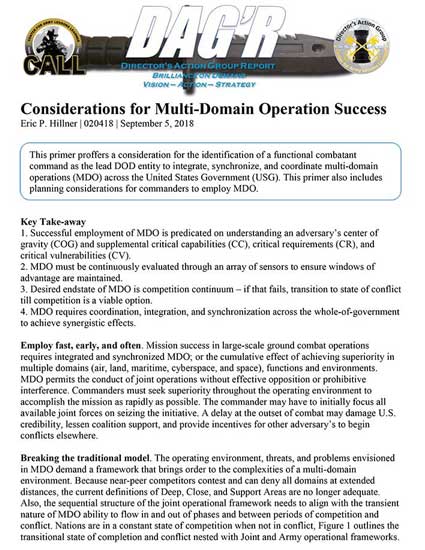 Director's Action Group Report - Considerations for Multi-Domain Operation Success
Director's Action Group Report - Considerations for Multi-Domain Operation Success
This primer proffers a consideration for the identification of a functional combatant command as the lead DOD entity to integrate, synchronize, and coordinate multi-domain operations (MDO) across the United States Government (USG). This primer also includes planning considerations for commanders to employ MDO.
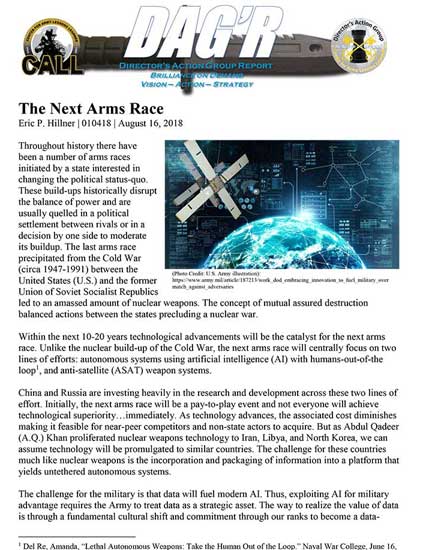 Director's Action Group Report - The Next Arms Race
Director's Action Group Report - The Next Arms Race
Within the next 10-20 years technological advancements will be the catalyst for the next arms race. Unlike the nuclear build-up of the Cold War, the next arms race will centrally focus on two lines of efforts: autonomous systems using artificial intelligence (AI) with humans-out-of-the loop, and anti-satellite (ASAT) weapon systems.
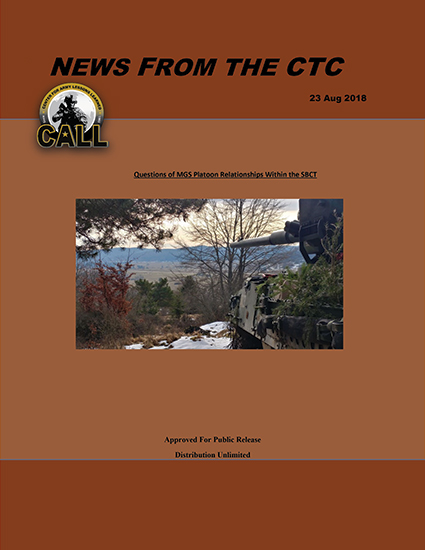 News From the CTC: Questions of MGS Platoon Relationships within SBCT
News From the CTC: Questions of MGS Platoon Relationships within SBCT
The purpose of this article is to discuss the command and control relationship and employment of the mobile gun system (MGS) platoon within the Stryker Brigade. The observations have been collected by the JMRC Observer Controllers during the unit’s rotational exercise.
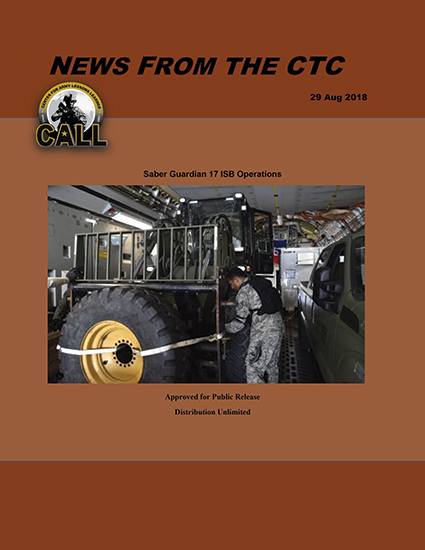 News From the CTC: Saber Guardian 17 ISB Operations
News From the CTC: Saber Guardian 17 ISB Operations
In July 2017, more than 25,000 service members from 22+ nations participated in one of the largest exercises in the Black Sea Region as part of exercise Saber Guardian 17 (SG 17). Key highlights of the exercise included the successful insertion of multinational airborne and special operations forces into multiple locations of the joint operations area and the use of an intermediate staging base (ISB) in Hungary to build combat power enroute.The goal of this paper is to provide insights, lessons learned, best practices, tactics, techniques, and procedures and other observations made by Observer Coach/Trainer (OC/T) teams from the Joint Multinational Readiness Center on the complexities of ISB operations during SG 17.
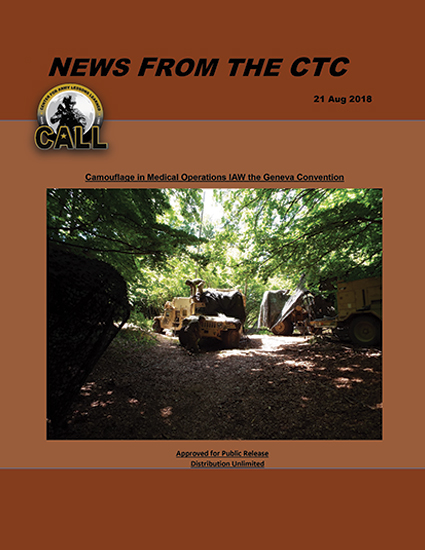 News From the CTC: Camouflage in Medical Operations
News From the CTC: Camouflage in Medical Operations
This article discusses the use of camouflage in medical operations. Specifically, it looks at the use of the red cross, facts surrounding the issue from a doctrinal standpoint, and common myths on the topic.
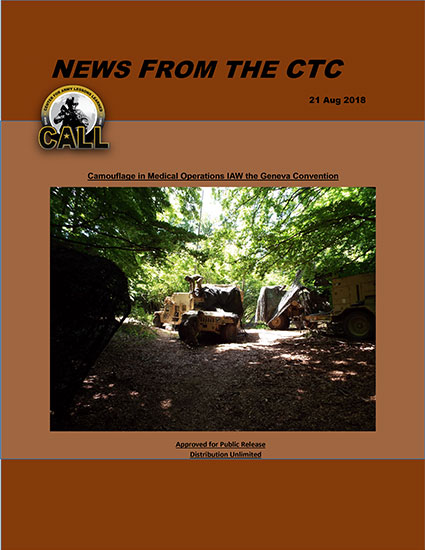 News From the CTC: Camouflage in Medical Operations
News From the CTC: Camouflage in Medical Operations
This article discusses the use of camouflage in medical operations. Specifically it looks at the need to use red crosses and the facts of the issue from a doctrinal standpoint dispelling common myths on the topic.

